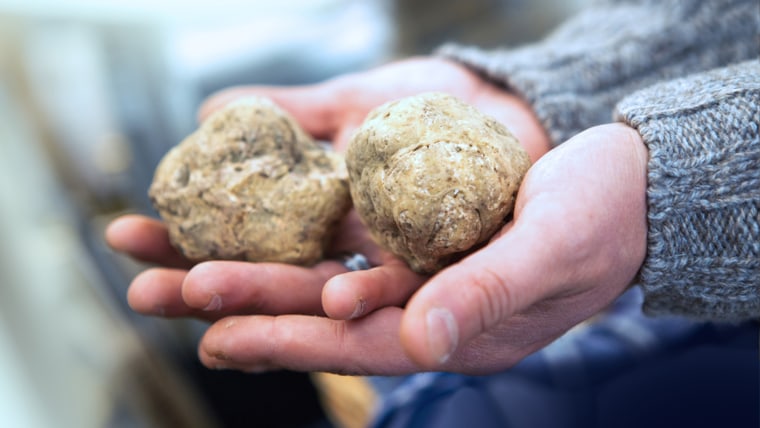In the hills of Italy’s Piedmont region, hunters set off to find their prey with a trusted dog by their side. But it’s not animals these men are hunting. It is Italy’s prized white truffle, or tartufo, as it is known in its country of origin.

Oddly shaped, with a strong odor — although some would call it an aroma — and covered in dirt, these fungi bring in thousands of dollars a pound. That’s right, thousands of dollars, for what is essentially a mushroom. This past weekend, Macau casino mogul Stanley Ho bid $330,000 for a pair of white truffles, including one weighing about 2 pounds. In 2007, Ho paid the same amount for a white truffle unearthed in Tuscany, and weighing about 3.3 pounds. Granted the auction proceeds were for charity, but what other food can bring in so much money and attention? What is it exactly that makes the white truffle so special?
“There is nothing else on the planet that smells and tastes like a white truffle,” said John Magazino of Primizie Fine Foods, which imports and distributes truffles around the U.S. “If a dish is prepared properly it is one of the best things you can eat. A lot of people say that they are not so special, but that is only because they haven’t been prepared properly.”
This year, prices for those who aren’t billionaires with cash to spare are hovering around $3,000 a pound in the U.S. White truffles range in size from an ounce to a pound, with really large ones weighing in at several pounds. They are traditionally eaten shaved over pasta, rice or egg dishes.
Growing demandWhite truffles are found in Italy’s Piedmont region — found, not grown, and not transplanted. In an age where tomatoes and mangoes are perpetually in season, this is one food that can’t be formulated in a lab or grown in a greenhouse.
“It has a very earthy flavor,” said Gerri Sarnataro, chef instructor at Institute of Culinary Education in New York, and owner of the Cucina della Terra cooking school in Umbria, Italy. “Depending on the kind of truffle you get, you can also taste hints of garlic. It is very different and much stronger than a mushroom. A truffle is much deeper and far more aromatic. You have to cut into it and smell it immediately to get the full effect.”
$25,000 sundae? 12 expensive eats
Every year, from September through December, hunters and their dogs scour the woods around Alba and the Piedmont region for these little gems. The dogs, which have come to replace pigs in recent years, can smell only the ripe, fully grown truffles. A good hunt can bring in several pounds of truffles; a bad hunt, none.
This year, truffle dealers are happily counting their money as truffles race off the shelves. Prices mostly depend on the supply that year, and although prices are down from last year, supply is also up. This year’s rainy spring, sunny summer and cool fall have led to a bumper crop.
In the U.S., demand for white truffles increases each year, as it has in emerging economies like China and the Middle East.
“After tasting white truffles in Europe while I was in college, I basically became obsessed and dedicated my existence to them,” said Magazino, who sells fresh white truffles for $198 per ounce through his website Primiziefinefoods.com. “Every year, we see that U.S. consumers have a broader knowledge and awareness about specialty foods from around the world. The white truffle is very popular now.”
But to the chagrin of truffle lovers everywhere, this prized fungus is getting harder and harder to find, and not only because of the added demand.
“Compared with 20 years ago, fewer truffles are coming to market,” said Veronica Giraudo, export manager at Tartuflanghe, a truffle retailer and specialty store located outside Alba that exports to top restaurants around the world. “The weather has changed, which accounts for much of the decline. Fall here is getting warmer and this is not good for truffles. In addition, over the last 20 years, many trees in the area have been cut down to plant vineyards, so the traditional places where hunters look for truffles are more limited.”
There is only one month to go in the 2010 white truffle hunting season, but as past history shows, next year should show no sign of flagging demand.
“What is it that makes the white truffle so special? Well, if they knew the answer to that, then people would duplicate it in a lab,” said Sarnataro. “It is just a relationship between whatever is in the earth and the roots of the tree. Until you have smelt the real thing, you don’t know what to look for and the more you are exposed to it, the more critical you become.”